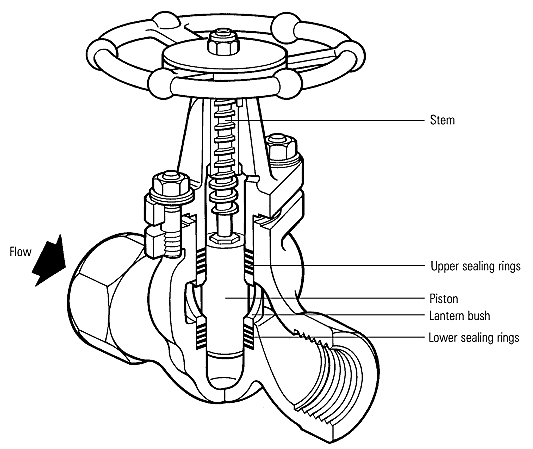A piston valve is a device used to control the motion of a fluid along a tube or pipe by means of the linear motion of a piston within a chamber or cylinder. 
In fact, the piston valve is a variant of the conventional globe valve, with the traditional seat and cone replaced by a piston and lantern bush. The piston is connected to the valve stem and hand wheel, and passes through two sealing rings that are separated by a lantern bush. When assembled, the two sets of sealing rings are compressed around the piston by the load exerted along the stem. The upper set of sealing rings acts as conventional gland packing, and the lower set acts as the seat. Furthermore, the large sealing area between the piston and rings assures a high level of shut-off tightness. 
A piston valve includes a body having an inlet on one end side of the body, a relief hole that opens on a sidewall of the body, a piston slid ably inserted in the body, a damper chamber formed in the body, and a spring disposed in the chamber and urging the piston toward the inlet. Controlled fluid flows into the body through the inlet, and is discharged through the relief hole. The piston is located between the inlet and the chamber in the longitudinal direction. An opening area of the relief hole is varied according to a position of the piston, in which the piston is balanced when pressure of controlled fluid applied to an inlet side-surface of the piston is equal to a sum of internal pressure of the chamber and reaction force of the spring, the sum being applied to a chamber side-surface of the piston.
The piston valve is not designed for throttling duties and must be used in the fully open or closed positions. When the valve is fully opened, only the bottom face of the piston is exposed to the fluid as the rest of the body is protected by the upper sealing rings. This means that the sealing surfaces (the sides of the piston) are protected from erosion by the fluid flow.
If the valve requires maintenance, all the internals can be easily removed by undoing the cover nuts and withdrawing the piston. The rings and the lantern bush can then be removed using an extractor tool. This operation is simple and can be undertaken without having to remove the valve from the pipeline. In general, the piston should never have to be replaced, but the sealing rings may wear over a long period with frequent operation.
Piston valves are usually used in the valve gear of many stationary steam engines and most steam locomotives.  In the 19th century, most steam locomotives used slide valves to control the flow of steam into and out of the cylinders. In the 20th century, slide valves were gradually superseded by piston valves, particularly in engines using superheated steam. There were two reasons for it. The first one is that with piston valves, the steam passages can be made shorter. This reduces resistance to the flow of steam and improves efficiency. The other one is that it is difficult to lubricate slide valves adequately in the presence of superheated steam.
In the 19th century, most steam locomotives used slide valves to control the flow of steam into and out of the cylinders. In the 20th century, slide valves were gradually superseded by piston valves, particularly in engines using superheated steam. There were two reasons for it. The first one is that with piston valves, the steam passages can be made shorter. This reduces resistance to the flow of steam and improves efficiency. The other one is that it is difficult to lubricate slide valves adequately in the presence of superheated steam.
Piston valves are also used in many brass instruments and pneumatic cannons.


 In the 19th century, most steam locomotives used slide valves to control the flow of steam into and out of the cylinders. In the 20th century, slide valves were gradually superseded by piston valves, particularly in engines using superheated steam. There were two reasons for it. The first one is that with piston valves, the steam passages can be made shorter. This reduces resistance to the flow of steam and improves efficiency. The other one is that it is difficult to lubricate slide valves adequately in the presence of superheated steam.
In the 19th century, most steam locomotives used slide valves to control the flow of steam into and out of the cylinders. In the 20th century, slide valves were gradually superseded by piston valves, particularly in engines using superheated steam. There were two reasons for it. The first one is that with piston valves, the steam passages can be made shorter. This reduces resistance to the flow of steam and improves efficiency. The other one is that it is difficult to lubricate slide valves adequately in the presence of superheated steam.